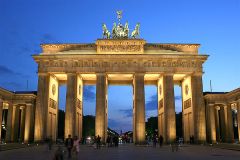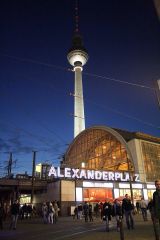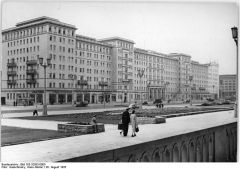![]()
![]()
![]()
Use LEFT and RIGHT arrow keys to navigate between flashcards;
Use UP and DOWN arrow keys to flip the card;
H to show hint;
A reads text to speech;
36 Cards in this Set
- Front
- Back
|
February 27, 1933
|
Reichstag fire, Marinus Van der Lubbe, used by nazis as an excuse to use suspend civil liberties.
|
|
|
January 20, 1942
|
Wannsee Conference, meeting of Nazi officials planing the final solution, Wannsee protocol stepped up the holocost, headed by Reinhart Heydrech
|
|
|
May 23, 1949
|
FRG established
|
|
|
October 7, 1949
|
GDR created
|
|
|
June 17, 1953
|
Anti-GDR protest suppressed by Soviets.
|
|
|
The Night of the Long Knives
|
Purge of enemies of the Nazi to secure control.
|
|
|
The Marshal Plan
|
The US initiative to provide economic aid to rebuild Europe and stop the spread of communism.
|
|
|
The Potsdam Conference
|
Meeting of US (Truman), GB (Atlee), and USSR (Stalin) to decide on the division and occupation military of Nazi territories.
|
|
|
Trümmerfrauen
|
Women who helped rebuild Germany after WWII.
|
|
|
Bonzen
|
GDR Party Bigwigs
|
|
|
The Stasi
|
The ministry of state security was the GDR secret police who spied on, captured, and tortured suspected energy of the state.
|
|
|
SED
|
Socialist Unity Party of Germany was the only real party in the GDR. It was a merger of the SPD and the KPD with Soviet influence but some autonomy.
|
|
|
FRG (Federal Republic of Germany)
|
The formal name of the West German state.
|
|
|
GDR (German Democratic Republic)
|
The formal name of the East German State.
|
|
|
Anti-Fascist Protective Barrier
|
The GDR name for the Berlin Wall, it was made to stop people fleeing the GDR, however the GDR claimed that it was to stop the fascist influences of the west. 1961.
|
|
|
Checkpoint Charlie
|
Was the main allied checkpoint for people wishing to enter East Berlin.
|
|
|
Joseph Goebbels
|
Reichs minister of propaganda, nazi ideologue.
|
|
|
Albert Speer
|
Was Hitlers architect and the Reichs minister of armaments and war production.
|
|
|
Leni Riefenstahl
|
Popular film maker in the Nazi era, made lots of propaganda film.
|
|
|
Lucius Clay
|
American military governor of allied occupied Germany, architect of 1948-1949 Berlin airlift.
|
|
|
Walter Ulbricht
|
Head of the SED and defacto and after 1960 formal head of state.
|
|
|
Erich Honecker
|
Succeeded Walter Ulbricht as the head of GDR, in office 1971-1989. Made economic reforms which allowed more freedoms.
|
|
|
Erich Mielke
|
Head of the Stasi from 1957-1989, never charged with Stasi Crimes but they got him on murders of two police cpts.
|
|
|
Josef Stalin
|
Dictator of the Soviet Union (1922-1952) brutally suppressive and exercised control over GDR.
|
|
|
Nikita Khrushchev
|
Soviet premier (1958-1964) who loosed the iron control the government exercised but he still brutally suppressed uprisings.
|
|
|
John F. Kennedy
|
President of the US expressed his support for Berlin after the wall went up.
|
|
|
Willi Brandt
|
Leader of the SPD and Chancellor of Germany from 1969-1974 opened up relationship between East and West.
|
|
|
Konrad Adenauer
|
Chancellor of GDR (1949-1963)
|
|
|
Wolf Biermann
|
East-German song writer who asked to preform in Cologne and then was not allowed to return to the GDR.
|
|
|
Peter Fechter
|
18 year old who was one of the first people who tried to escape the GDR over the Berlin Wall and was shot which was a rallying against GDR.
|
|
|
The Reichstag
|
Built 1884-1894, Paul Wallot
|
|
|
Potsdamer Platz
|
Bussy square near Brandenburg gate, destroyed during WWII
|
|
|
Potsdamer Platz
|

|
|
|
Brandenburg Gate
|

Built 1791, Architect Carl Gottard Longhans, during the Cold War it was a gate between east and west but was closed after west protests against the wall.
|
|
|
Alexander Platz
|

Large public square in Mitte. Has the famous Berlin TV tower. The TV tower or Fernsehturm was complete in 1969 by Herman Henselman. It is ironic because when the sun shines on it right it appears to form a cross.
|
|
|
Stalinallee
|

Stalinallee huge boulevard in a typically socialist style intended as monument to communism and the worker. After the death of Stalin and after he became a less popular symbol the street was renamed Karl Marx Allee in 1961.
|

